Nature Post!
Not a very amazing nature post, but it's early spring and the weather has been weirdly warm, which seems to have confused the plants. It's lovely to see everything starting to turn beautiful and green again.
Found some interesting flowers I don't think I've identified before, including one that doesn't appear to belong here, Also found a bit of fungus activity, although not much in the way of standard mushrooms (those will come later, and whatever morels have come up have been picked already).

I showed you this one before, but it's the very common Claytonica virginica, otherwise known as the Virginia or eastern spring beauty. It is certainly a beauty, and if you can see the very faintest hint of stripes on the flowers, those would show up brilliantly in ultraviolet if you happened to be a bee.
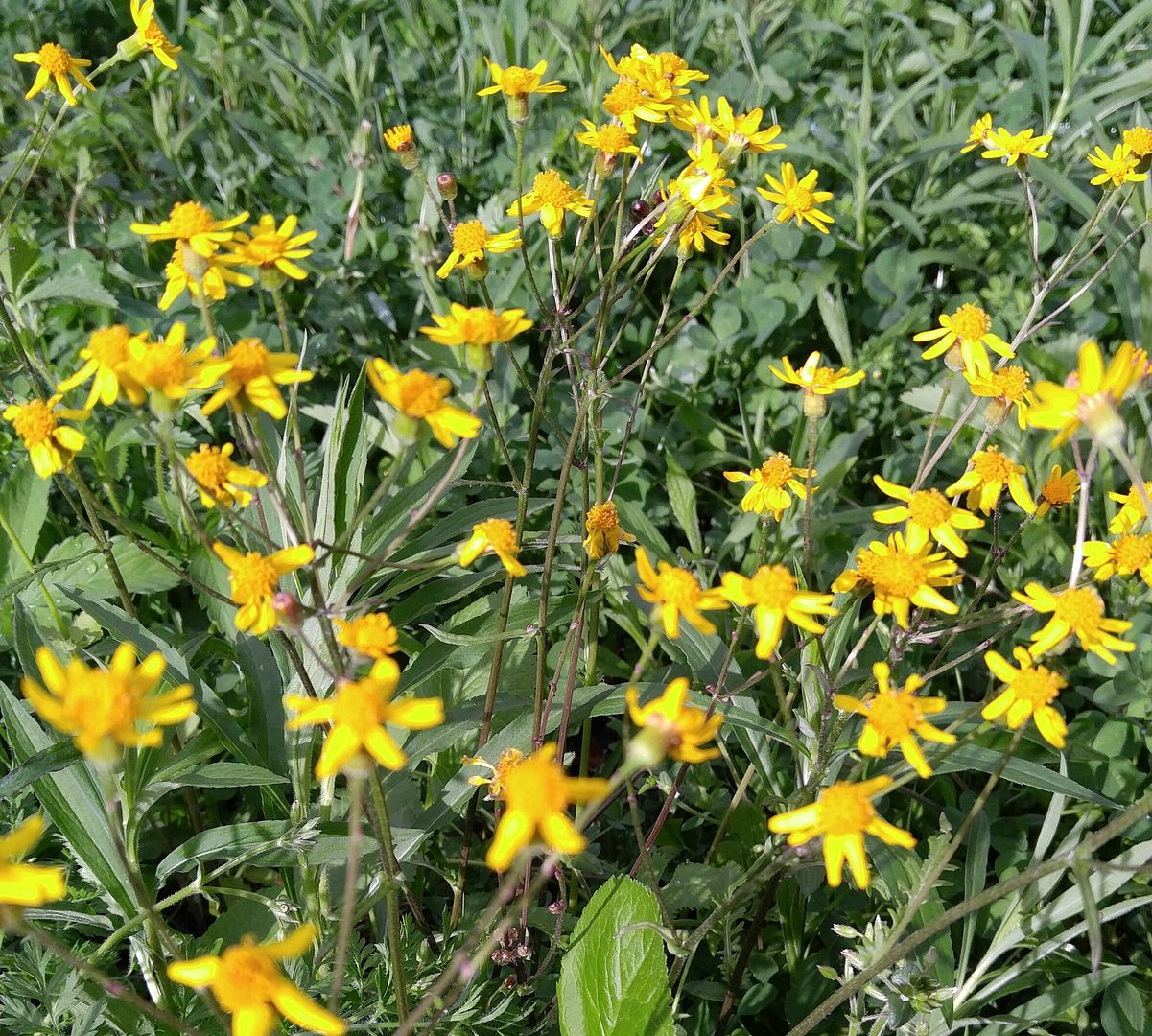
Packera aurea (renamed from Senecio aurea for no obvious reason) is the widely despised North American native known as ragweed, blamed for miserable runny noses and other spring allergy symptoms. In reality, ragweed is probably not the allergy culprit at all, being a very minor contributor to the overall pollen load, but it is extremely common and its flowering coincides with the pollinating of many trees and other early wind-pollinated plants, leaving ragweed to take the blame (since many people don't even realize most trees make pollen since they don't make noticeable flowers).
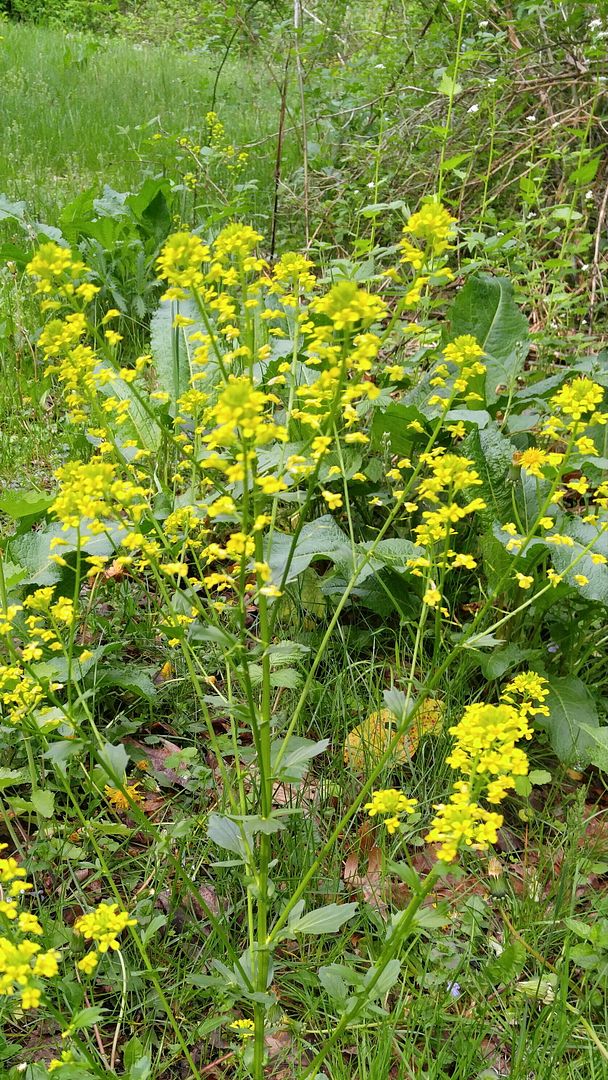
Very, very, very common in a wet spring and continuing to flourish through the summer (without the golden blooms), this is the naturalized non-native weed Barbarea vulgaris. Common names include bittercress and yellow rocket; the name "vulgaris" indicates just how common it is. It belongs to the mustard family.
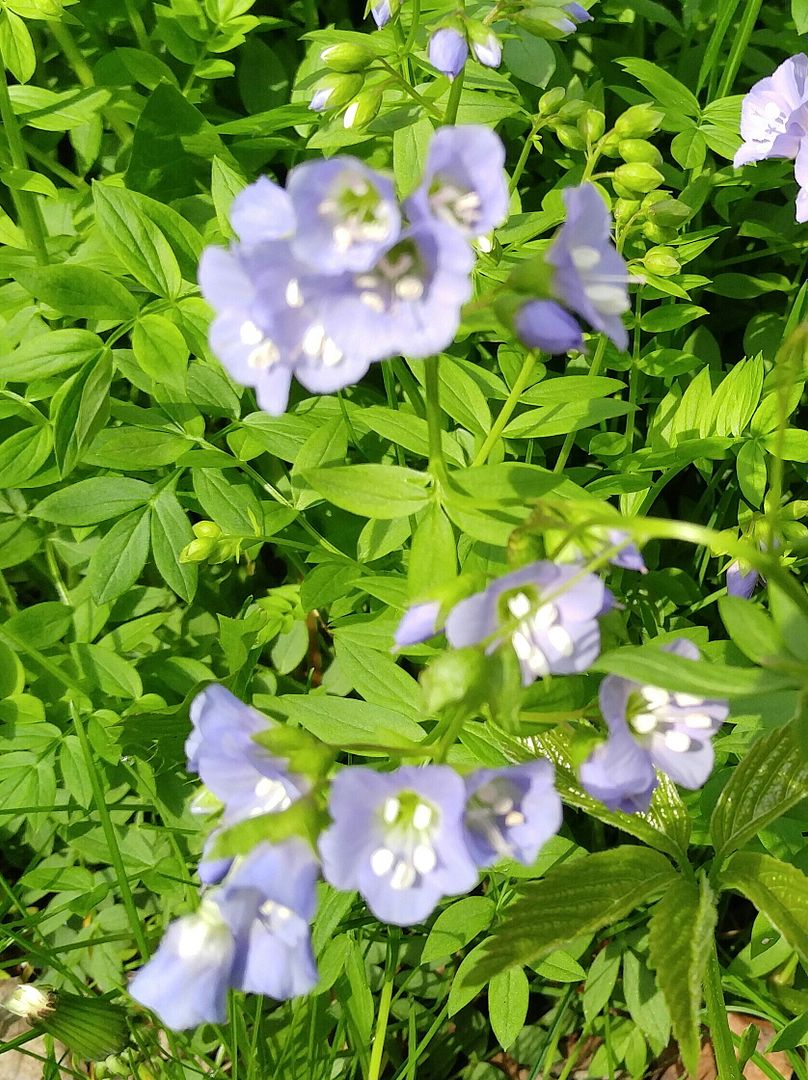
This is the odd one out, because as far as I've been able to find out, this is Polemonium caeruleum, with the common names Greek valerian or Jacob's ladder (it is not the only plant to use this common name, so I prefer Greek valerian). It's odd because some websites report that it is a native of Europe and others that it's native to North America... some places list a rather different-looking plant under the same scientific name and the common name Jacob's ladder, while others list one that looks more like this one with the same scientific name and the common name Greek valerian. Either way, it's pretty, and is a perennial garden flower that tolerates our cold winters regardless.
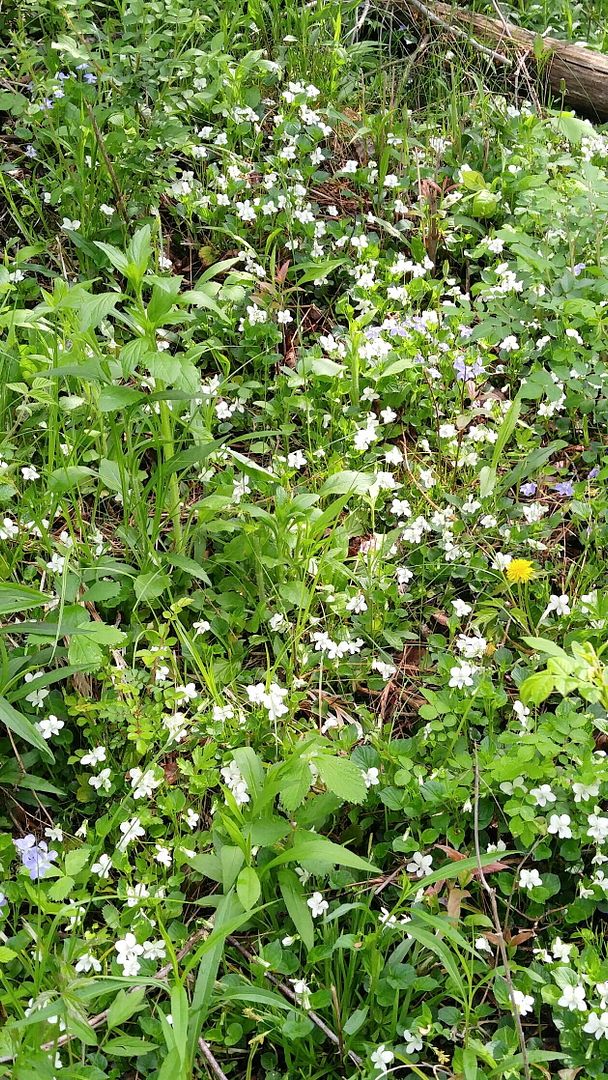
Most violets are violet, but these ones are white. They are color variants of the same species, as far as I've been able to find out, and you do find them growing together, although since violets spread by underground root systems, one color tends to dominate an area.
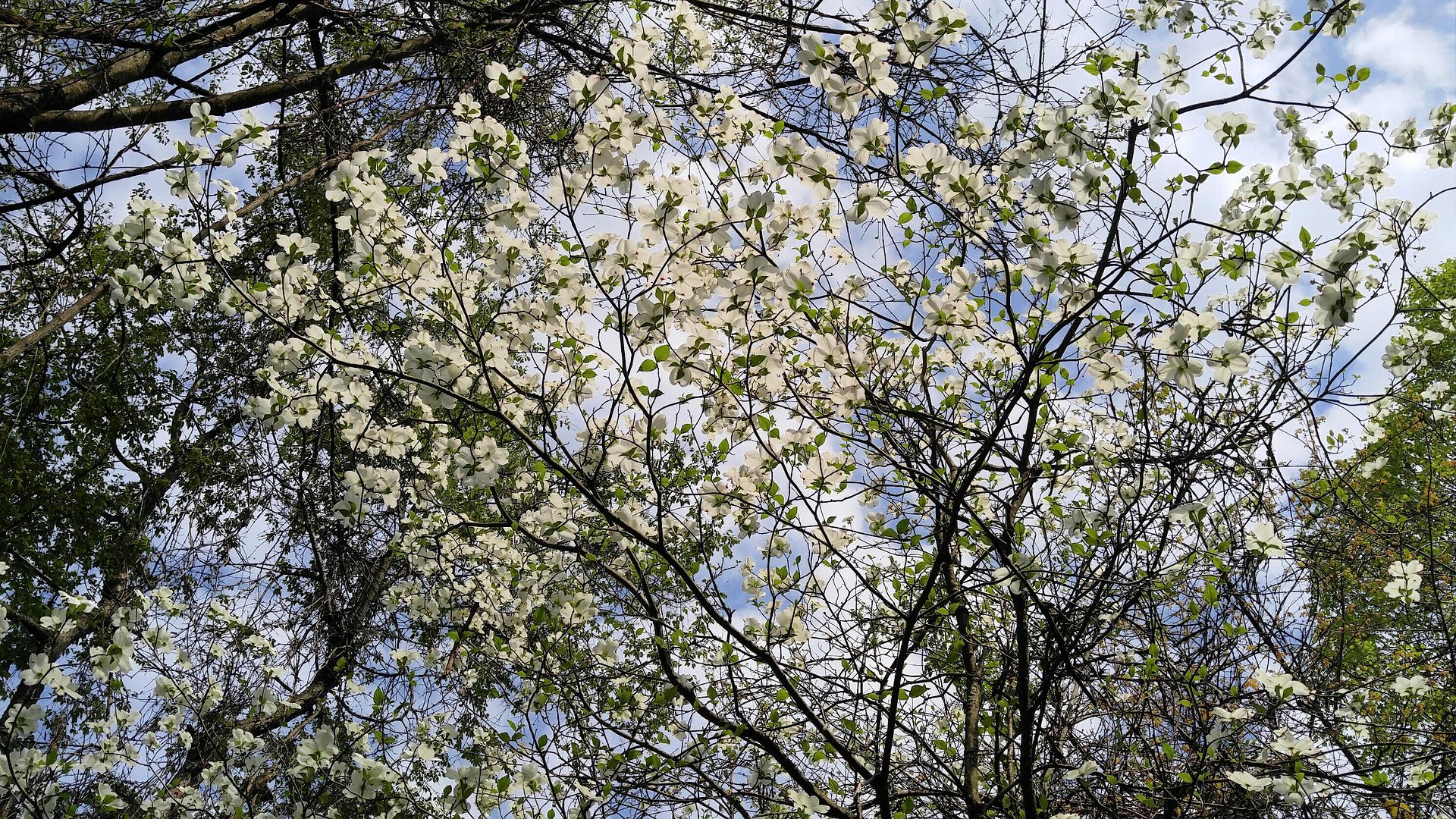
Beautiful flowers of dogwood, one of the prettiest and most widespread flowering trees in this area (Cornus florida). Popular all over North America as landscape trees, these are small trees with very unique and attractive flowers... that aren't actually flowers at all, as you'll see in the next picture. During the 1970's and 1980's, both wild and landscape specimens of these trees were seriously endangered by a fungus blight called dogwood anthracnose, I remember my mother diligently pruning the ones in our yard when I was a child, removing infected branches. This blight still exists and can still be a problem, but several severe years of blight left the population carrying plenty of resistant genes.

This is not a flower.
Well, those little yellowish-green knobs in the middle are actually flowers. The white things are not petals; they are bracts, which are actually modified leaves. These flowers are characteristic of Cornus florida an some relatives, but many members of the genus Cornus have regular white flowers. It's not clear why some dogwoods went for the bracts... magnolias and other primitive flowering trees have bracts instead of petals because they are very old, but despite their primitive-looking flowers, dogwoods are not in that group.

Virginia creeper, the crawling vine that's differentiated from poison ivy by its five leaves (poison ivy has three). It's also differentiated by the way it grows... poison ivy vines are dense and covered with shaggy hairs that grip the bark. Virginia creeper uses these charming little "suckers" that are designed specifically to cling to bark and support the vine as it grows.
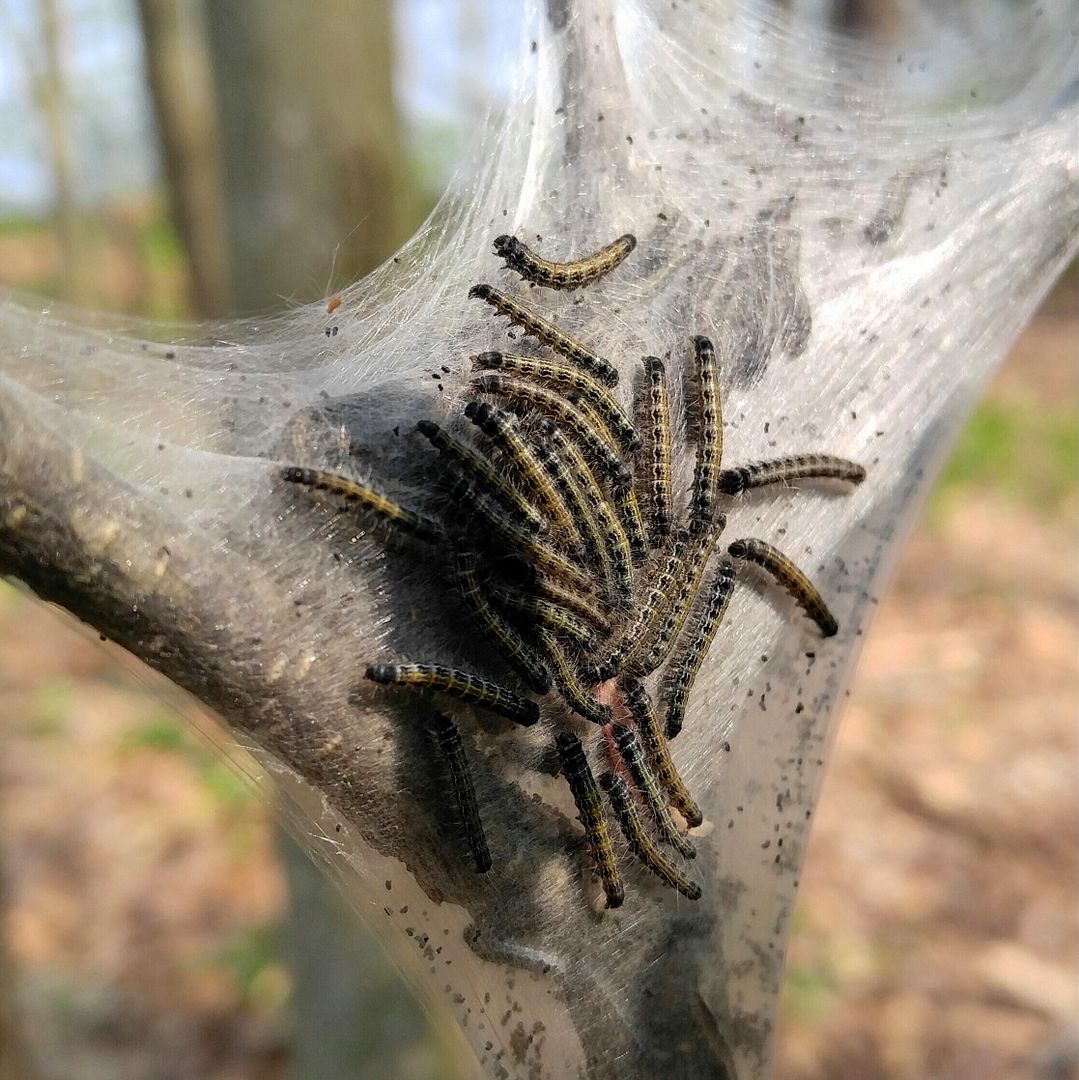
Tent caterpillars are just about as popular as ragweed and really are much worse. In an average season they will do some pretty heavy munching on the tree they live in, but in a bad year they can completely defoliate it and move on to nearby victims. Fortunately, most trees can tolerate one season of this, although multiple seasons of it are bad news.
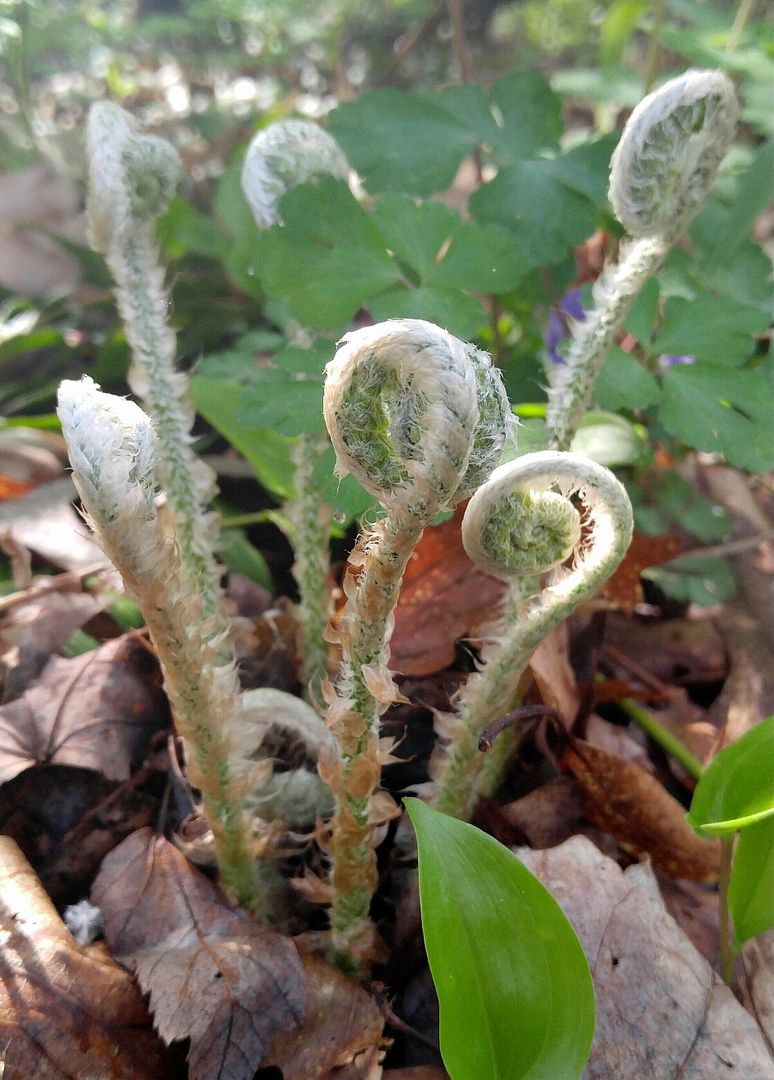
Just because everyone has already seen the little uncoiling fronds of ferns doesn't make them any less cool.

The may apples are awake, as expected, and this year they seemed to pop up all at once and very quickly as the weather warmed up faster than usual. The one at the top of the picture is a non-reproductive... with just one umbrella, it will spend the summer collecting energy and hoping to one day be ready to come up as something like the little one at the bottom. It's hard to tell in this picture, but this one will have two umbrellas and the little flower (and later hard green fruit) between them.
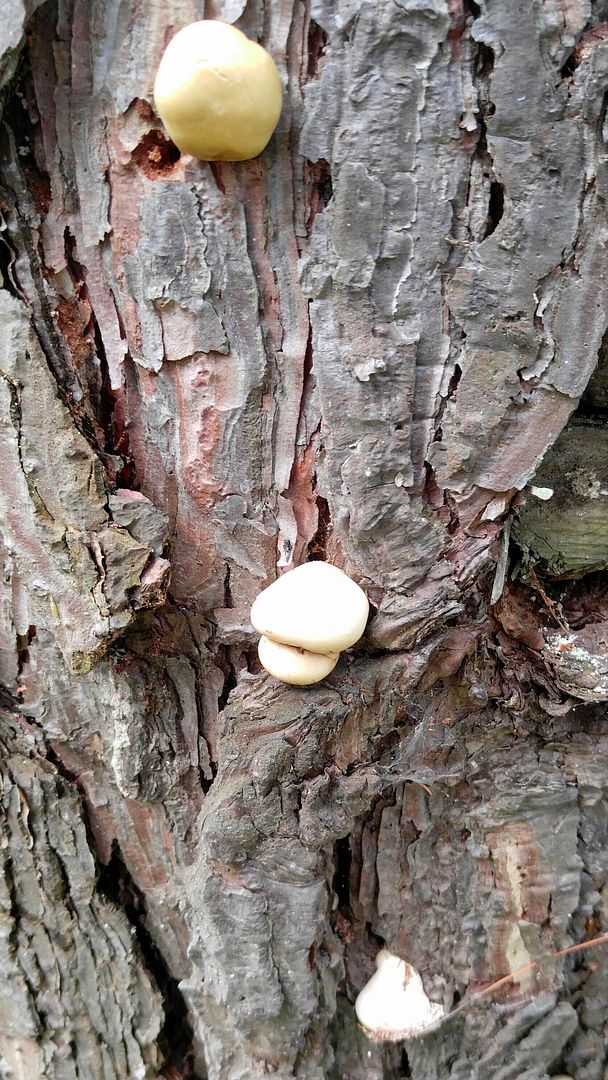
Little lumps of future shelf fungi, although these ones are on a pine tree instead of on birches where I usually find them. If there's a tree, there's a species or subspecies of polypore that specializes on it. No matter which one it is, their little budding shelves are a bad sign and mean this tree's days are numbered; the fungus has spread its hyphae extensively through the wood and is happily digesting it.
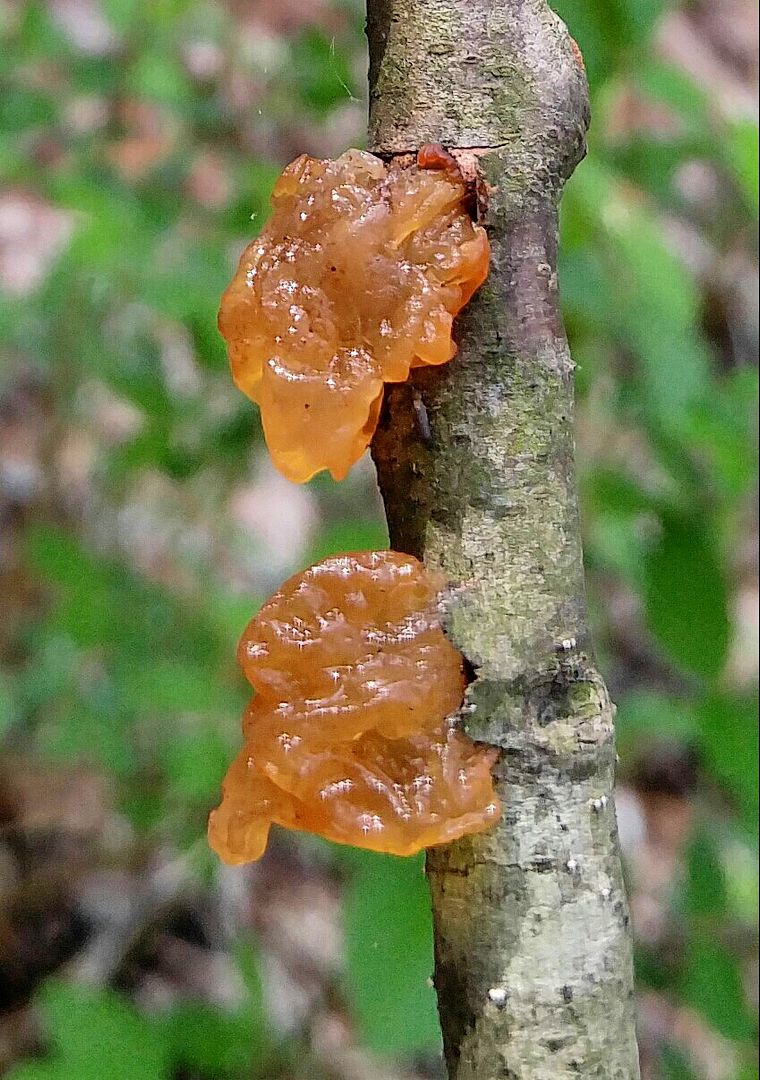
These oddities are a jelly fungus, and good luck on deciding exactly what kind; they go by all kinds of bizarre common names and they change shape and color depending on how wet they are. These ones, having been exposed to a bunch of rain, are fairly plump, but in a drier period they would be shrunken and almost impossible to spot. Apparently, many jelly fungi are edible, but none of them are noted to be very tasty... some people will eat just about anything, I suppose.
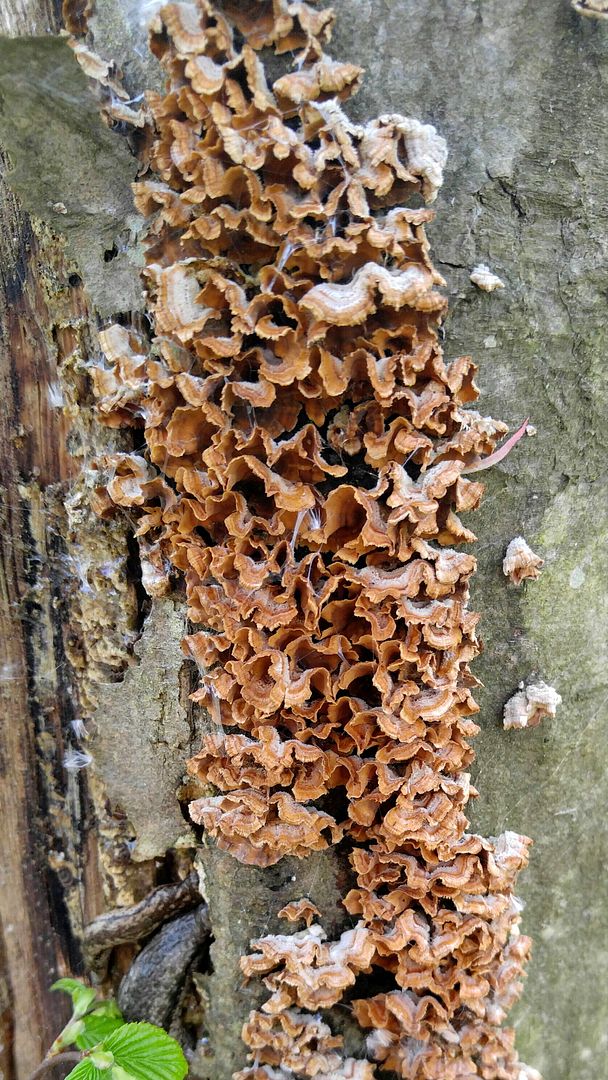
These sorts of crusty little shelves usually grow on dead wood, but sometimes they'll get to work before the tree is actually dead. Any tree that's got fungi fruiting on it is in the process of being eaten, and that's usually not a good thing.
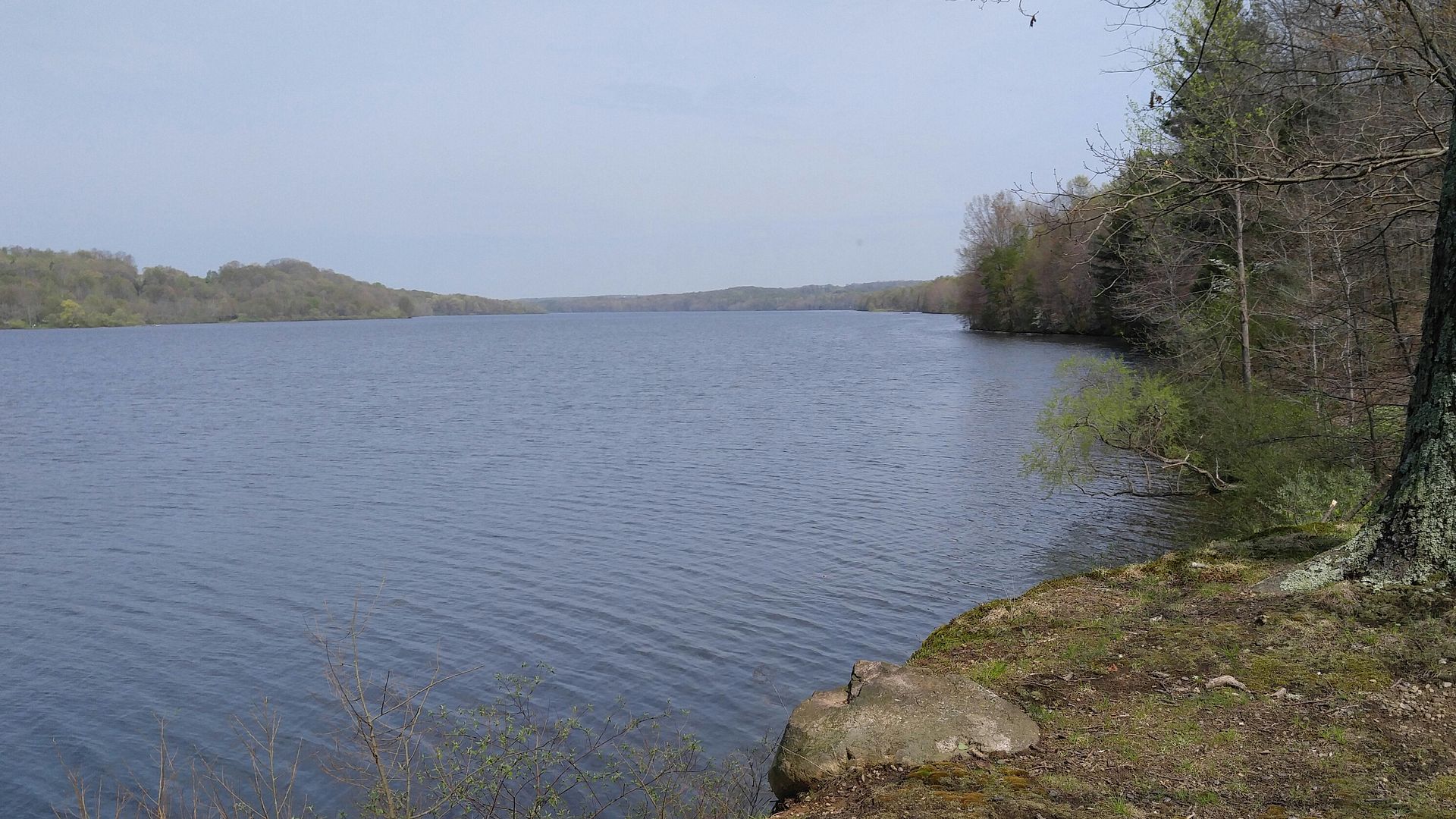
This is the view from a high point sticking out over the lake, one that's almost impossible to get to once all the underbrush has come in. This was the first time in years I'd wandered out here, and it gave me the chance to take some pictures of a phenomenon that I find interesting... beaver activity.

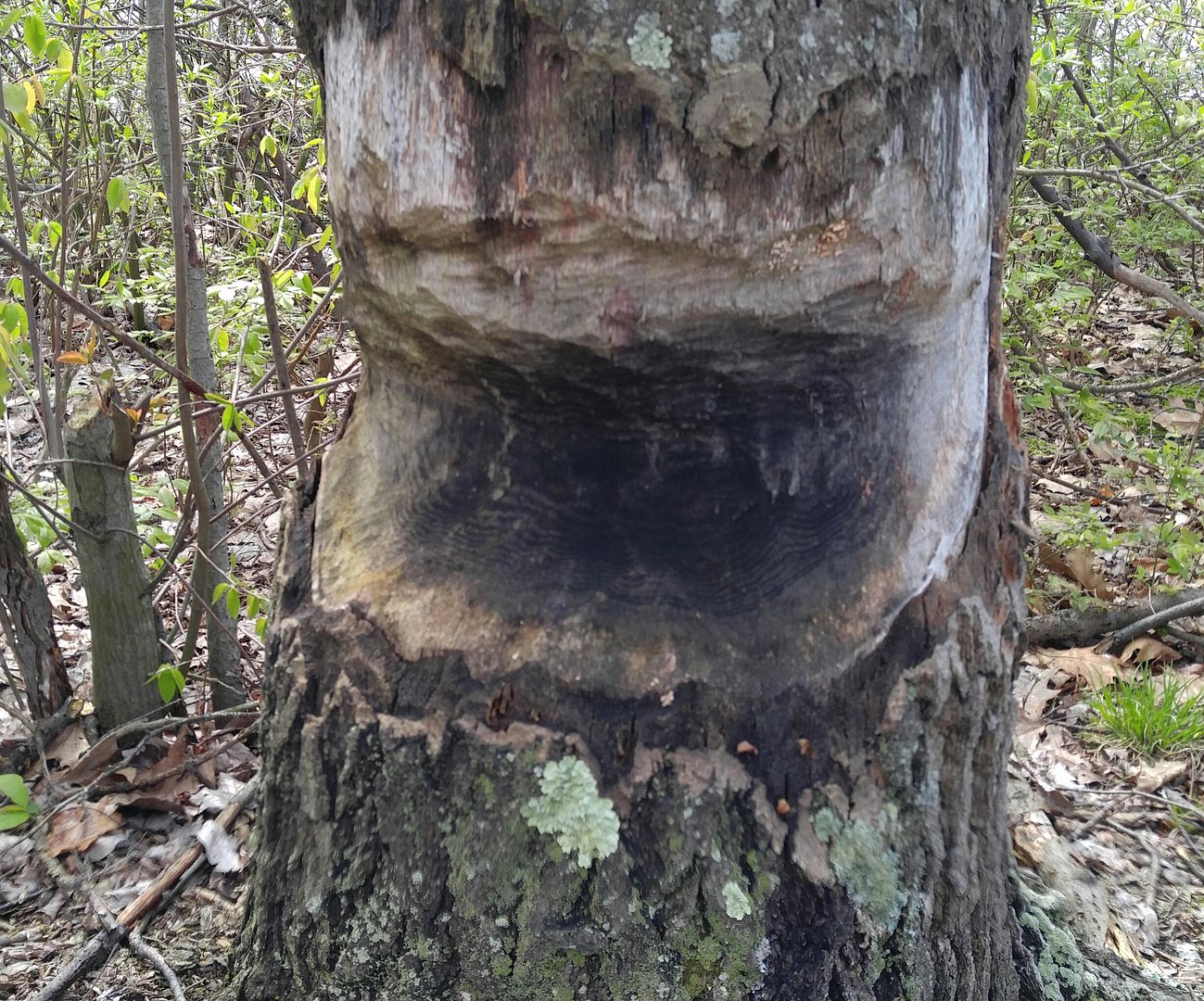
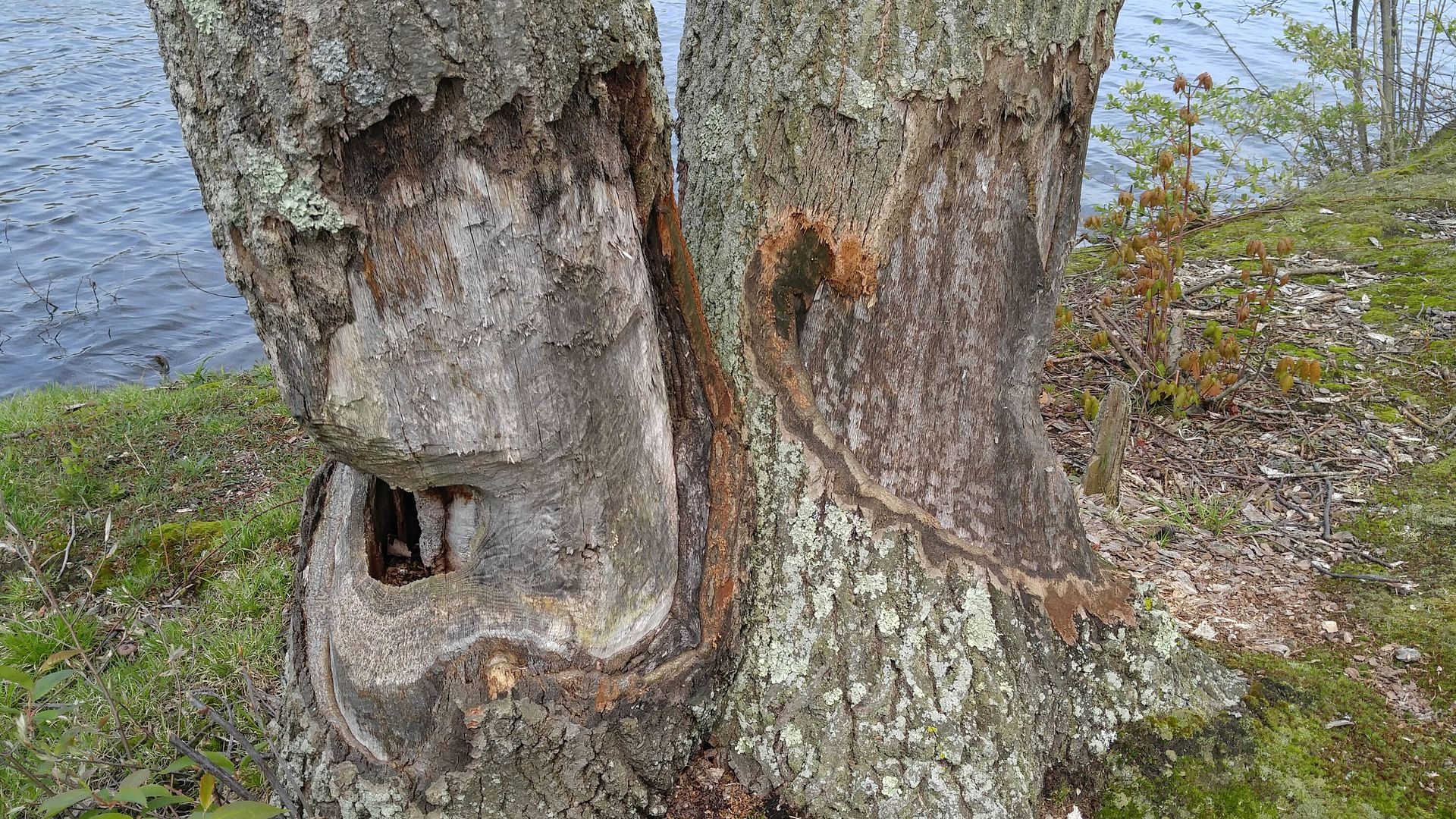
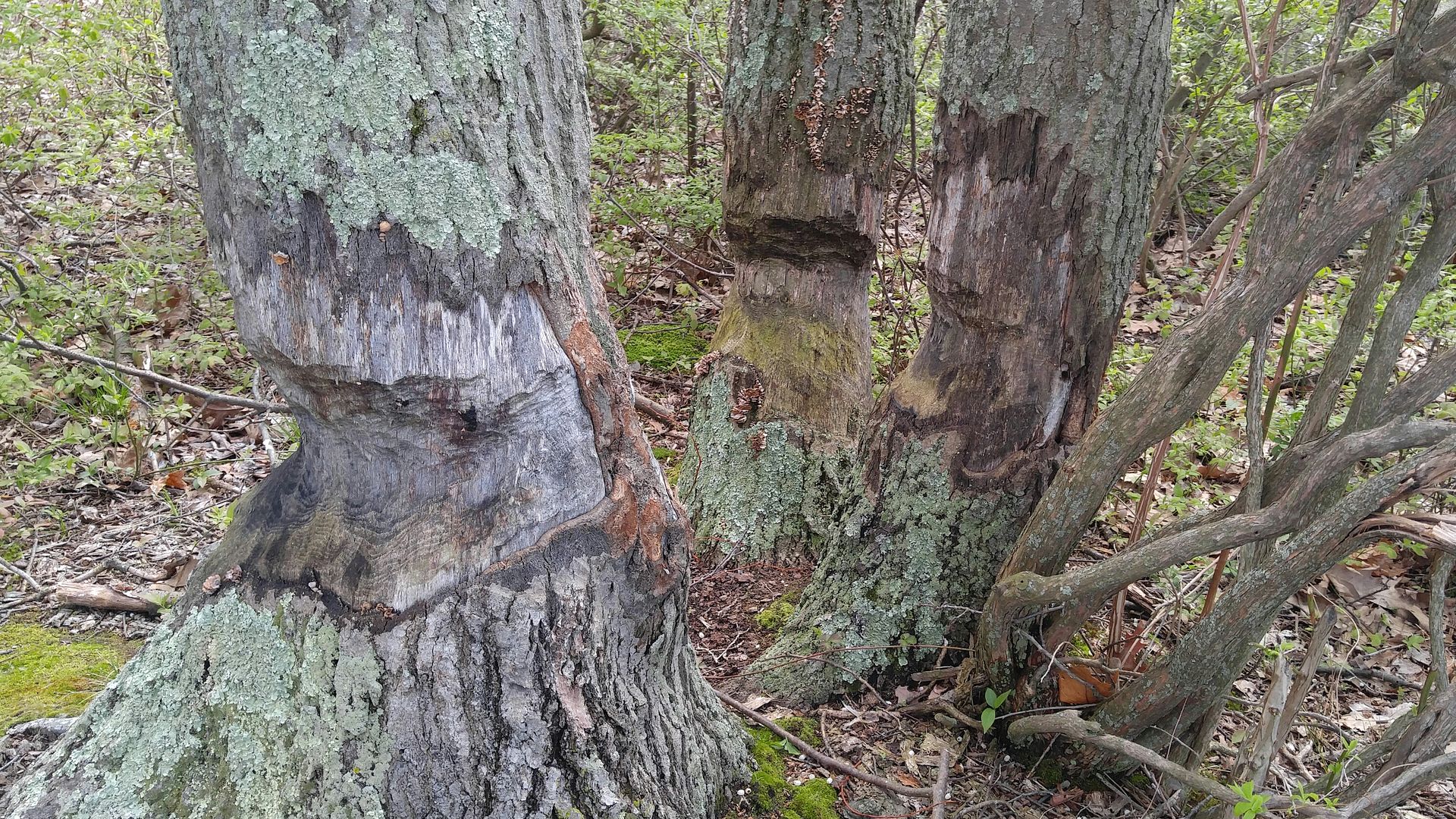
I still find fresh beaver-chewed trees along the edge of the lake, so there are definitely some beavers still around. However, these trees are old and abandoned, and they're up on a narrow little high point about as far above the water as you can get around here. It's been a long time since any beavers have been up here.
The dam that formed my lake was only built in 1971, and its main purpose was flood control on the rapidly fluctuating creek, which had a bad habit of flooding the nearby town. It's entirely possible that before the lake was created, there were beavers here working on creating a dam of their own. There were probably lots of other beaver-chewed trees, but these ones are still here because they have actually survived the damage and are still alive to testify to the work of their attackers.
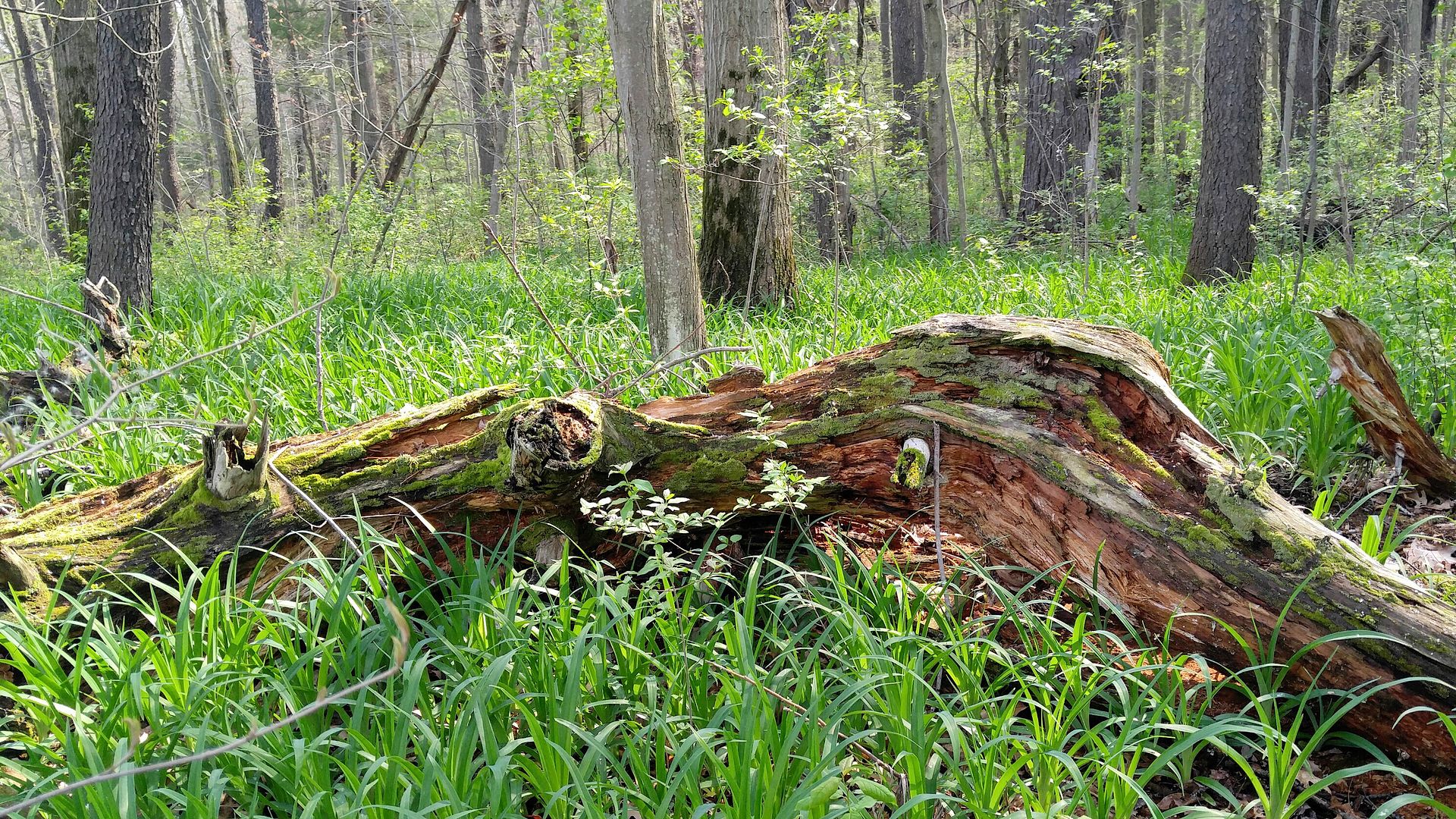
I've been watching this fallen tree slowly decay for years now, and it always looks pretty in the spring surrounded by the early, bright green leaves of tiger lilies.
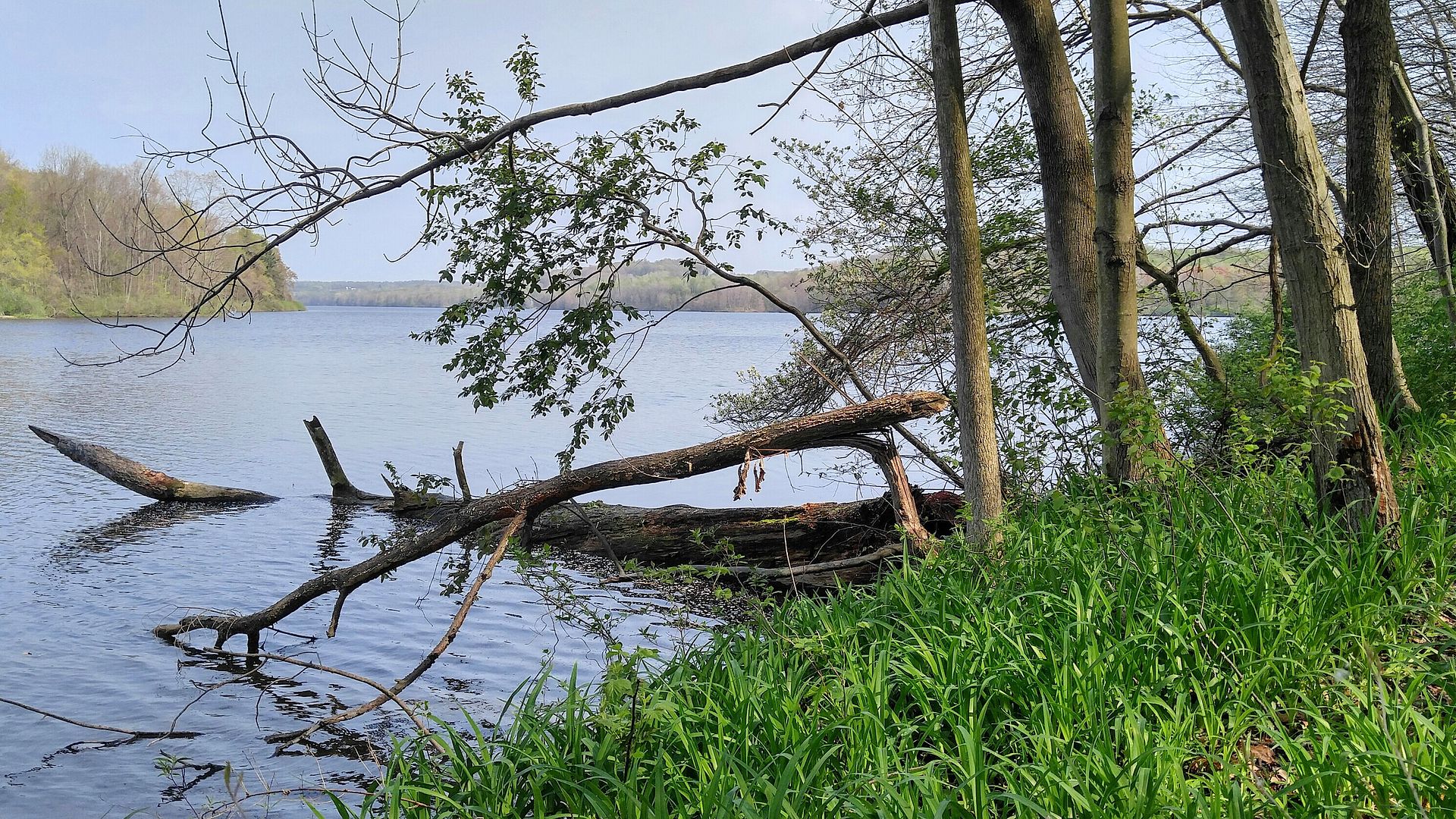
More tiger lilies (without their flowers, at this point) and some lake.
.
.
.
Found some interesting flowers I don't think I've identified before, including one that doesn't appear to belong here, Also found a bit of fungus activity, although not much in the way of standard mushrooms (those will come later, and whatever morels have come up have been picked already).

I showed you this one before, but it's the very common Claytonica virginica, otherwise known as the Virginia or eastern spring beauty. It is certainly a beauty, and if you can see the very faintest hint of stripes on the flowers, those would show up brilliantly in ultraviolet if you happened to be a bee.

Packera aurea (renamed from Senecio aurea for no obvious reason) is the widely despised North American native known as ragweed, blamed for miserable runny noses and other spring allergy symptoms. In reality, ragweed is probably not the allergy culprit at all, being a very minor contributor to the overall pollen load, but it is extremely common and its flowering coincides with the pollinating of many trees and other early wind-pollinated plants, leaving ragweed to take the blame (since many people don't even realize most trees make pollen since they don't make noticeable flowers).

Very, very, very common in a wet spring and continuing to flourish through the summer (without the golden blooms), this is the naturalized non-native weed Barbarea vulgaris. Common names include bittercress and yellow rocket; the name "vulgaris" indicates just how common it is. It belongs to the mustard family.

This is the odd one out, because as far as I've been able to find out, this is Polemonium caeruleum, with the common names Greek valerian or Jacob's ladder (it is not the only plant to use this common name, so I prefer Greek valerian). It's odd because some websites report that it is a native of Europe and others that it's native to North America... some places list a rather different-looking plant under the same scientific name and the common name Jacob's ladder, while others list one that looks more like this one with the same scientific name and the common name Greek valerian. Either way, it's pretty, and is a perennial garden flower that tolerates our cold winters regardless.

Most violets are violet, but these ones are white. They are color variants of the same species, as far as I've been able to find out, and you do find them growing together, although since violets spread by underground root systems, one color tends to dominate an area.

Beautiful flowers of dogwood, one of the prettiest and most widespread flowering trees in this area (Cornus florida). Popular all over North America as landscape trees, these are small trees with very unique and attractive flowers... that aren't actually flowers at all, as you'll see in the next picture. During the 1970's and 1980's, both wild and landscape specimens of these trees were seriously endangered by a fungus blight called dogwood anthracnose, I remember my mother diligently pruning the ones in our yard when I was a child, removing infected branches. This blight still exists and can still be a problem, but several severe years of blight left the population carrying plenty of resistant genes.

This is not a flower.
Well, those little yellowish-green knobs in the middle are actually flowers. The white things are not petals; they are bracts, which are actually modified leaves. These flowers are characteristic of Cornus florida an some relatives, but many members of the genus Cornus have regular white flowers. It's not clear why some dogwoods went for the bracts... magnolias and other primitive flowering trees have bracts instead of petals because they are very old, but despite their primitive-looking flowers, dogwoods are not in that group.

Virginia creeper, the crawling vine that's differentiated from poison ivy by its five leaves (poison ivy has three). It's also differentiated by the way it grows... poison ivy vines are dense and covered with shaggy hairs that grip the bark. Virginia creeper uses these charming little "suckers" that are designed specifically to cling to bark and support the vine as it grows.

Tent caterpillars are just about as popular as ragweed and really are much worse. In an average season they will do some pretty heavy munching on the tree they live in, but in a bad year they can completely defoliate it and move on to nearby victims. Fortunately, most trees can tolerate one season of this, although multiple seasons of it are bad news.

Just because everyone has already seen the little uncoiling fronds of ferns doesn't make them any less cool.

The may apples are awake, as expected, and this year they seemed to pop up all at once and very quickly as the weather warmed up faster than usual. The one at the top of the picture is a non-reproductive... with just one umbrella, it will spend the summer collecting energy and hoping to one day be ready to come up as something like the little one at the bottom. It's hard to tell in this picture, but this one will have two umbrellas and the little flower (and later hard green fruit) between them.

Little lumps of future shelf fungi, although these ones are on a pine tree instead of on birches where I usually find them. If there's a tree, there's a species or subspecies of polypore that specializes on it. No matter which one it is, their little budding shelves are a bad sign and mean this tree's days are numbered; the fungus has spread its hyphae extensively through the wood and is happily digesting it.

These oddities are a jelly fungus, and good luck on deciding exactly what kind; they go by all kinds of bizarre common names and they change shape and color depending on how wet they are. These ones, having been exposed to a bunch of rain, are fairly plump, but in a drier period they would be shrunken and almost impossible to spot. Apparently, many jelly fungi are edible, but none of them are noted to be very tasty... some people will eat just about anything, I suppose.

These sorts of crusty little shelves usually grow on dead wood, but sometimes they'll get to work before the tree is actually dead. Any tree that's got fungi fruiting on it is in the process of being eaten, and that's usually not a good thing.

This is the view from a high point sticking out over the lake, one that's almost impossible to get to once all the underbrush has come in. This was the first time in years I'd wandered out here, and it gave me the chance to take some pictures of a phenomenon that I find interesting... beaver activity.




I still find fresh beaver-chewed trees along the edge of the lake, so there are definitely some beavers still around. However, these trees are old and abandoned, and they're up on a narrow little high point about as far above the water as you can get around here. It's been a long time since any beavers have been up here.
The dam that formed my lake was only built in 1971, and its main purpose was flood control on the rapidly fluctuating creek, which had a bad habit of flooding the nearby town. It's entirely possible that before the lake was created, there were beavers here working on creating a dam of their own. There were probably lots of other beaver-chewed trees, but these ones are still here because they have actually survived the damage and are still alive to testify to the work of their attackers.

I've been watching this fallen tree slowly decay for years now, and it always looks pretty in the spring surrounded by the early, bright green leaves of tiger lilies.

More tiger lilies (without their flowers, at this point) and some lake.
.
.
.